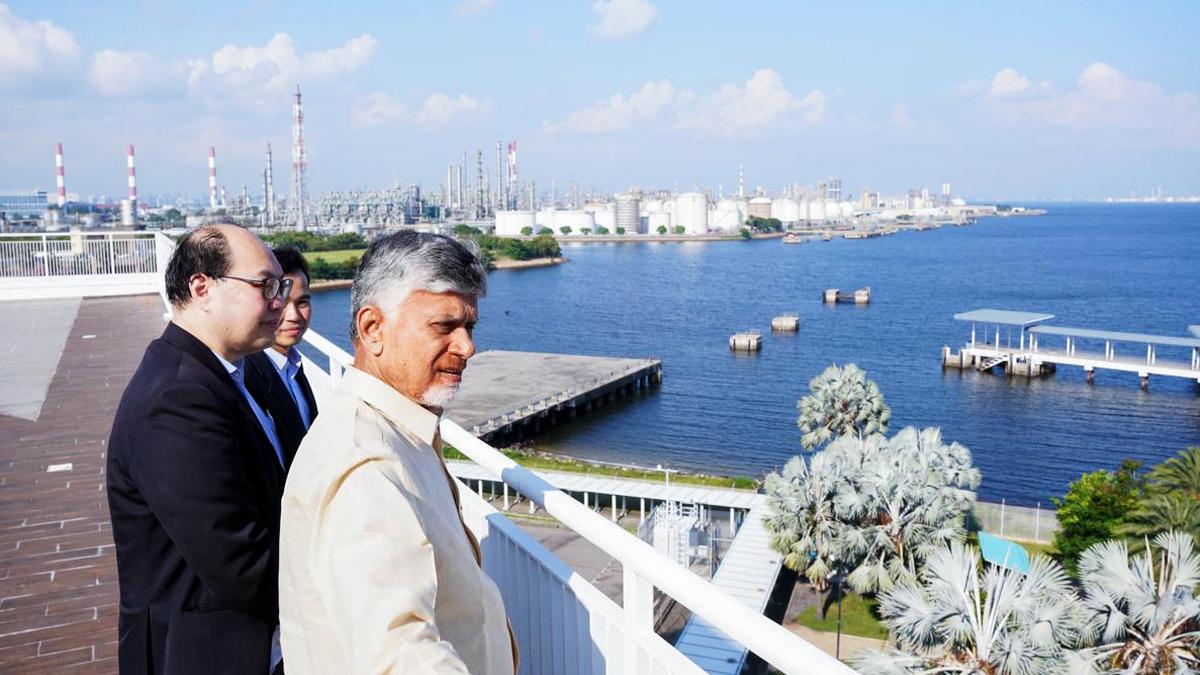
Andhra Pradesh Chief Minister N Chandrababu Naidu visits Jurong Island, Singapore’s flagship integrated petrochemical and energy hub, during his official visit to Singapore. File photo: @AndhraPradeshCM X/ANI Photo
Andhra Pradesh Chief Minister N. Chandrababu Naidu’s visit to Singapore from July 26 to 30 was a strategic exercise in economic diplomacy — an effort to reaffirm his government’s commitment to building a globally competitive investment climate while quietly distancing the State from the shadow of policy volatility that marked the previous YSRCP regime.
Mr. Naidu’s foreign between 2014 and 2019 and now in 2025 are stories of contrasts. Between 2014 and 2019, in his first term as Chief Minister of a State that had been newly bifurcated, Mr. Naidu wanted to create a capital, attract foreign investment, and market Andhra Pradesh as an innovation-led region. Amaravati was the centrepiece of this vision, and Singapore played a starring role through consultancy company Surbana Jurong’s master plan.

His first-round global engagements were aspirational. They focused on building brand Andhra, learning best practices in governance, agriculture, and infrastructure, and positioning the State as the ‘Sunrise Andhra Pradesh’. The results were mixed: he secured significant goodwill and several MoUs, but political headwinds and fiscal constraints meant that not all plans matured into reality.
In 2025, the circumstances could not be more different. Returning to power after defeating the YSRCP, Mr. Naidu has inherited a State grappling with damaged investor confidence, policy reversals, and economic slowdown. This time, his travels have the urgency of a rescue mission. The rhetoric has shifted from building something entirely new to repairing and restoring what was lost. The narrative now is ‘Reset and Rebuild Andhra Pradesh’.
One of the most notable shifts inMr. Naidu’s 2025 pitch is its geographic focus.The spotlight has moved from Amaravati to Visakhapatnam, now framed as the State’s economic nucleus. Amaravati — once his crowning vision — was derailed, mocked, and abandoned under the previous regime. By contrast, Visakhapatnam offers a compelling narrative: a coastal city with thriving port infrastructure, tech parks, and emerging data clusters, well-positioned as the ‘Gateway to Southeast Asia’.
Singapore investors were told of opportunities in green hydrogen, quantum computing, and digital infrastructure. Mr. Naidu’s meetings highlighted Google’s interest in establishing a data centre, alongside new housing projects with Surbana Jurong and an Eversendai facility. These signals were meant to show that Andhra Pradesh is back on the map for cutting-edge sectors.
Yet the conversations in Singapore were inevitably shaped by the past. The YSRCP government’s abrupt withdrawal from key Singapore-linked projects remains fresh in institutional memory.
From 2019 to 2024, several high-profile MoUs and joint ventures with Singaporean entities were unilaterally cancelled or left to wither. This had a chilling effect, not just in Singapore but in global business circles that had been watching Andhra Pradesh’s trajectory. While no official in Singapore publicly criticised the previous administration during Mr. Naidu’s visit, the message during private conversations was reportedly that they would “revert after making an internal assessment”.
The Telugu diaspora’s embrace of Naidu was unambiguous. Over 2,500 NRIs gathered to greet him. But in boardrooms, investors wanted to see sustained stability and early wins before making major commitments.
Mr. Naidu knows the criticism from his first term — that too many MoUs failed to materialise — still hangs over him. This time, he cannot afford a repeat. For Naidu 2.0 to succeed, agreements must translate into jobs, infrastructure, and visible economic growth.
If the Singapore trip yields tangible results within the next year and a half, Mr. Naidu will not only consolidate his position at home but also set a precedent for how Indian chief ministers can leverage foreign engagements to drive State-level economic diplomacy. If not, critics will portray it as an expensive exercise in public relations, echoing the opposition YSRCP’s current claims that the visit was more show than substance.
The stakes in 2025 are higher than in 2014. Back then, Mr. Naidu had the luxury of time and the novelty of leading a new State. Today, he faces a compressed political calendar and the burden of repairing both the state’s economic narrative and his own political legacy. Ultimately, the Singapore visit is less a victory lap than the opening move in a long, complex game.
Published – August 18, 2025 12:56 am IST
